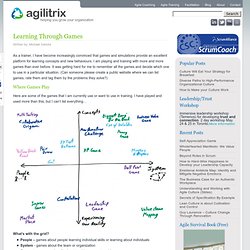

The Blame Game. ©2007, 2009 Don Gray and Jerry Weinberg Engelbert watched Pam nervously chew on her knuckle as she stood in the door of his office, answering his call.
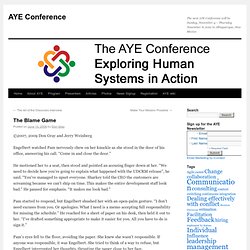
“Come in and close the door.” He motioned her to a seat, then stood and pointed an accusing finger down at her. “We need to decide how you’re going to explain what happened with the UDCRM release”, he said. “You’ve managed to upset everyone. Pam started to respond, but Engelbert shushed her with an open-palm gesture. Pam’s eyes fell to the floor, avoiding the paper. “Pam, don’t even think NOT signing this memo. Multitasking-Name-Game.pdf. Rocket to Mars: A Sprint Planning Game. “Many team and their product owners believe that the team's unique job is to deliver more and more story points, but we consider this to be a complete misunderstanding of the relation between the team and the product owner” said Damien Thouvenin and Pierrick Revol.

At the XP Days Benelux 2013 conference, Damien and Pierrick facilitated a sprint planning game for teams and product owners to learn about deciding to invest their sprint time to produce stories, investigate issues, reduce technical debt, or do training. Initially team members are only skilled to do one activity, by doing training they can develop new skills. When team members have these skills they are able to do different activities and the team will become more multidisciplined and capable to do more work in an iteration. Damian and Pierrick asked the teams what they have learned from playing the game. Learn KANBAN by Playing a Game. There is no better way the learn then by doing.

And games are a great way to do that and very popular in the Agile community. Here is a game by Masa K Maeda one of The Agilista PM’s popular speakers. Serious Games. Agile Airplane Game. This is the multi-team airplane game that we use to introduce Agile through games.
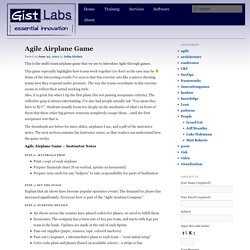
This game especially highlights how teams work together (or don’t as the case may be Some of the interesting results I’ve seen is that this exercise acts like a mirror showing teams how they respond under pressure. The way the teams coordinate in this exercise seems to reflect their actual working style. Also, it is great fun when I rip the first plane (for not passing acceptance criteria). The collective gasp is always entertaining. The downloads are below for intro slides, airplanes I use, and a pdf of the instructor notes. Step 0: Materials Prep Print 1 copy of each airplanePrepare financials chart ($ on vertical, sprints on horizontal)Prepare note cards for any “helpers” to take responsibility for parts of facilitation Step 1: Set the stage Explain that air shows have become popular spectator events. Step 2: Starting details. Scrum-Simulation-with-LEGO-Bricks-v2.0.pdf. LitheSpeed : Agile and Scrum Training, Coaching and Enterprise Consulting.
We do a lot of training here at LitheSpeed, and our exercises are consistently among the most popular parts of our courses.
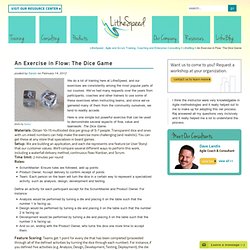
We’ve had many requests over the years from participants, coaches and other trainers to use some of these exercises when instructing teams, and since we’ve garnered many of them from the community ourselves, we tend to readily accede. Here is one simple but powerful exercise that can be used to demonstrate several aspects of flow, value and teamwork: The Dice Game. Learn KANBAN by Playing a Game. Kanban pizza game. Scrum Lego City. With the Scrum Lego City from agile42 you can find out how powerful Scrum can be.

Scrum Lego City by agile42 is licensed under a Creative Commons Attribution-Share Alike 3.0 License. LInk to buy the Material Amazon.deAmazon.com Material. Multitasking game - Hands/Numbers/Song. Kanban-Pizza-Game. The Kanban Pizza Game by agile42 is licensed under the Creative Commons Attribution-Share Alike 3.0 License . It’s difficult to teach the principles of Lean and Agile simply by lecturing. People have to experience the principles by themselves to get a feeling for how it all works. By playing a game, you can gain experience without messing up your daily work or getting engrossed in the technical details. TastyCupcakes.org. Agile. {*style:<li>*} {*style:<br>*}{*style:<h3>*}{*style:<a href=' MatchUp Canvas{*style:</a>*}{*style:</h3>*}Posted by {*style:<a href=' Gottesdiener{*style:</a>*} on August 14th, 2018 at 5:27 pm{*style:<br>*} Great teams act interdependently to achieve product outcomes.
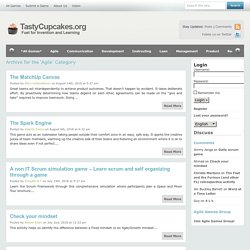
That doesn’t happen by accident. It takes deliberate effort. Mastering the Obvious. One of the most vivid sessions I took part in at the Play4Agile conference in Germany last month was a session on Games for Distributed Teams.

Led by the amazing Silvana Wasitova, this discussion built on the preceding session about “Games in 5 Minutes” to explore how these activities can be used with distributed teams. I was hoping to get some new ideas for games to use with teams that are not colocated, since in my experience it’s rarer and rarer to find teams where everyone is located in the same city, let alone the same office. While we talked about and tried some games that could be played across a group of people connected only by a phone line*, for me the fascinating part was how this experience could also be used to demonstrate why there is really no good substitute for in-the-same-room face-time for teams that need to work together. My discomfort started with the distributed seating arrangement in the room. The difference in the two experiences was astonishingly visceral.
Lean Simulations. Learning Through Games. As a trainer, I have become increasingly convinced that games and simulations provide an excellent platform for learning concepts and new behaviours.
